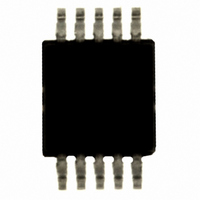SI4010-B1-GT Silicon Laboratories Inc, SI4010-B1-GT Datasheet - Page 85

SI4010-B1-GT
Manufacturer Part Number
SI4010-B1-GT
Description
IC TX 27-960MHZ FSK 3.6V 10MSOP
Manufacturer
Silicon Laboratories Inc
Series
EZRadio®r
Type
ISM Transmitterr
Datasheets
1.4010-DAAKF_434.pdf
(2 pages)
2.SI4010-B1-GS.pdf
(160 pages)
3.SI4010-C2-GS.pdf
(156 pages)
Specifications of SI4010-B1-GT
Package / Case
10-MSOP, Micro10™, 10-uMAX, 10-uSOP
Frequency
27MHz ~ 960MHz
Applications
Garage Openers, RKE, Security Alarms
Modulation Or Protocol
FSK, OOK
Data Rate - Maximum
100 kBaud
Power - Output
10dBm
Current - Transmitting
19.8mA
Data Interface
PCB, Surface Mount
Antenna Connector
PCB, Surface Mount
Memory Size
4kB RAM
Features
8051 MCU Core, Crystal-less Operation
Voltage - Supply
1.8 V ~ 3.6 V
Operating Temperature
-40°C ~ 85°C
Operating Frequency
27 MHz to 960 MHz
Maximum Operating Temperature
+ 85 C
Mounting Style
SMD/SMT
Operating Supply Voltage
1.8 V to 3.6 V
Supply Current
10 mA
Lead Free Status / RoHS Status
Lead free / RoHS Compliant
Other names
336-1973-5
- Current page: 85 of 160
- Download datasheet (831Kb)
Note that by using the unified CODE/XDATA memory and by mapping the IRAM to the boot process
address space the user can initialize both XDATA and IRAM variables directly from the User NVM load
without the need for running any startup code to do variable initializations, resulting in the saving of a code
size.
One application of the data initialization by a boot process could be copying of keys from the NVM to fixed
locations without any code intervention. The user can program all the chips with the same application in
the factory and then add only a very small, per chip, User block with keys, specifying where to the XDATA
and/or IRAM memories the boot process should copy the values of the keys.
For example, to initialize IRAM location 0x56 to 0xA4 value the user will provide and IntelHEX file specify-
ing that at the address 0x7056 the data value should be 0xA4.
23.10. NVM Programming
The NVM programming can be done only by the Silicon Labs provided data preparer and programmer. The
data preparer will take user generated application IntelHEX files, user directives, and will generate data to
be programmed into the NVM. The NVM programmer then programs the data into the NVM. In the end the
NVM programming will be handled by a single stand alone application.
During the programming process the user will have control of the following:
1. Make Factory part a User part .. program User data into the NVM
2. Update User part .. add additional User data block to the existing User data already in NVM. This
3. Make User part a Run part .. mark a part as a final mission mode part. When making the part a Run
These steps can be combined into a single programming step. Step 2. is optional and is convenient when
part specific data needs to be added later to the NVM load.
process can be done many times as long as there is a space in NVM.
part the user can decide whether the part retest will be allowed and if so, then what protection
restrictions the user is going to impose during the retest process.
Rev. 0.5
Si4010
85
Related parts for SI4010-B1-GT
Image
Part Number
Description
Manufacturer
Datasheet
Request
R
Part Number:
Description:
SI4010-C2-GSR
Manufacturer:
Silicon Laboratories Inc
Datasheet:
Part Number:
Description:
MSOP 10/I°/SOC RF TRANSMITTER WITH 8051
Manufacturer:
Silicon Laboratories Inc

Part Number:
Description:
IC TX 27-960MHZ FSK 3.6V 10MSOP
Manufacturer:
Silicon Laboratories Inc
Datasheet:
Part Number:
Description:
IC TX 27-960MHZ FSK 3.6V 14SOIC
Manufacturer:
Silicon Laboratories Inc
Datasheet:
Part Number:
Description:
IC TX 27-960MHZ FSK 3.6V 14SOIC
Manufacturer:
Silicon Laboratories Inc
Datasheet:
Part Number:
Description:
SMD/C°/SINGLE-ENDED OUTPUT SILICON OSCILLATOR
Manufacturer:
Silicon Laboratories Inc
Part Number:
Description:
Manufacturer:
Silicon Laboratories Inc
Datasheet:
Part Number:
Description:
N/A N/A/SI4010 AES KEYFOB DEMO WITH LCD RX
Manufacturer:
Silicon Laboratories Inc
Datasheet:
Part Number:
Description:
N/A N/A/SI4010 SIMPLIFIED KEY FOB DEMO WITH LED RX
Manufacturer:
Silicon Laboratories Inc
Datasheet:
Part Number:
Description:
N/A/-40 TO 85 OC/EZLINK MODULE; F930/4432 HIGH BAND (REV E/B1)
Manufacturer:
Silicon Laboratories Inc
Part Number:
Description:
EZLink Module; F930/4432 Low Band (rev e/B1)
Manufacturer:
Silicon Laboratories Inc
Part Number:
Description:
I°/4460 10 DBM RADIO TEST CARD 434 MHZ
Manufacturer:
Silicon Laboratories Inc
Part Number:
Description:
I°/4461 14 DBM RADIO TEST CARD 868 MHZ
Manufacturer:
Silicon Laboratories Inc
Part Number:
Description:
I°/4463 20 DBM RFSWITCH RADIO TEST CARD 460 MHZ
Manufacturer:
Silicon Laboratories Inc










